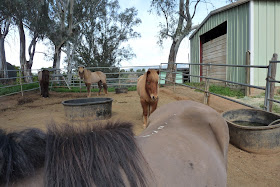 By: Dan Kidder
By: Dan KidderThe rough, unforgiving terrain and frigid winters of Iceland made survival on the island impossible for all but the hardiest early settlers.
And in order to navigate that terrain, tame the land for crops and protect themselves in times of war, those early settlers needed a horse that could handle the harsh life.
Necessity brought about the Icelandic breed of horses, but today, the unique little horse is valued for its intelligence, good temperament and versatility.
Here in Valley Center, Jerilyn Lagus knew she found the right horse for her from the moment she found Icelandics.
“I had a beautiful Paint horse that had to be put down when it was only nine years old,” she says. “So I looked for a horse that was going to last.”
The answer proved to be Icelandics, a small breed that falls right on the classification border between horse and pony. Thick-legged and shaggy-haired, the hardy little horses are usually right around four and a half feet tall and come in a wide variety of colors. Originally brought to the Nordic island by Scandinavian settlers more than 1,100 years ago, the horses quickly proved their worth as reliable saddle horses, pack animals, plow horses and even war horses.
Icelandics are known to live into their 40s and are commonly used for breeding until the age of 30. And not only are they long-livers, they seem genuinely to enjoy life, wherever they happen to be. They are characteristically good-natured, docile, easy to break and very friendly, but they are far from boring. Naturally inquisitive, they learn quickly and are almost fearless. They live well in stables and corrals, but thrive when they get to spend even part of the year in their natural environment, even when the weather drives some animals (and people) to hibernation.
“There are no natural predators in Iceland, so they just don’t get afraid,” Lagus says. “That’s one of the challenges of raising them elsewhere. A lot of horses have died from snakebites because they think it’s a stick or something harmless.”
One more characteristic that makes Icelandics unique is their gait. The breed is the only five-gaited breed in the world, able to walk, trot and gallop, as is common with most horses, but also able to tölt and pace. The tölt is a four-beat ambling lateral gait, similar to the high-hoofed style of the Tennessee Walking Horse, but able to move more quickly. The pace, also called the flying pace, is a smooth style in which the horse moves its left front and rear legs in unison, then follows suit with its right front and rear legs. While the tölt is natural for all Icelandic horses, although it must be refined through training to achieve show-quality results, the flying pace is a gait that only some Icelandics can perform. These five-gait horses are prized for this ability and are sought-after for breeding.
Because Iceland has strict legislation regarding its horses, the Icelandic breed is the only breed in the country. No other livestock animals are imported, and once an Icelandic horse leaves the island, it cannot return. These restrictions result in very few diseases in the horse population, but make it difficult for Icelandic breeders to show their horses in international competitions.
The Lagus family has four Icelandics; three mares and a gelding. The male is named Odinn, while the females are named Fjola, Snaelda and Eva. While the Lagus’ are getting their eight acres on Anthony Ridge Road ready for the horses, they are currently stabled at Harmony Ranch, where Heidi Helly uses them to teach her horsemanship students.
“My granddaughters learned to ride when they were three and five years old, and Heidi’s students ride them too,” Lagus says. “I’ve never seen one kick a person, they’re good trail horses, and they’re almost dog-like because they’ll follow you around.”
Lagus is a registered nurse and a member of the North American Riding for the Handicapped Association (NARHA), and because of the Icelandic’s mellow temperament, she says she would like to use her horses to help disabled or physically challenged people learn to ride in a relaxed atmosphere.
“We used to have [an Icelandic] stallion, and when we moved, he went to [the] Helen Woodward [Animal Center] to be used as a therapeutic animal,” she says. “And I want to get my horses involved with NARHA because they’re so easy to handle. We want to use them for more than just our family. They’re so good, they don’t get nervous, and they’re great with people who have physical difficulties or with kids.”
Lagus recently joined the Valley Center Vaqueros with her Icelandics, and her daughter Sonja Bedolla, along with granddaughters Mikayla and Madison, have participated in past Vaqueros shows as well.






No comments:
Post a Comment